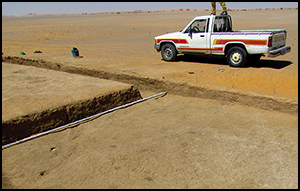Article contents
Affad 23: settlement structures and palaeoenvironments in the Terminal Pleistocene of the Middle Nile Valley, Sudan
Published online by Cambridge University Press: 19 July 2016
Abstract

The Epipalaeolithic of the Levant witnessed important changes in subsistence behaviour, foreshadowing the transition to sedentism and cultivation, but much less is known of contemporary developments in the Middle Nile Valley. Here, Affad 23, a 16000-year-old settlement, on the margins of a resource-rich, multi-channel floodplain, offers exceptional insights. Unusually good preservation has left the remains of pits and postholes, indicating the construction of temporary shelters and specialised functional zones. The Affad 23 community successfully exploited a wide range of riverine resources, and created a highly organised seasonal camp adjacent to convenient, resource-rich hunting grounds. Surprisingly, they continued to exploit Levallois-like tools, rather than adopting the new technologies (e.g. microliths) that were then evolving in Upper Egypt.
- Type
- Research
- Information
- Copyright
- Copyright © Antiquity Publications Ltd, 2016
References
- 8
- Cited by




